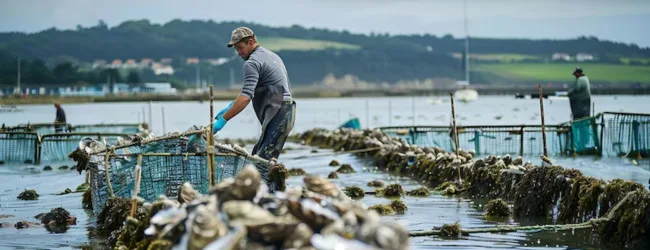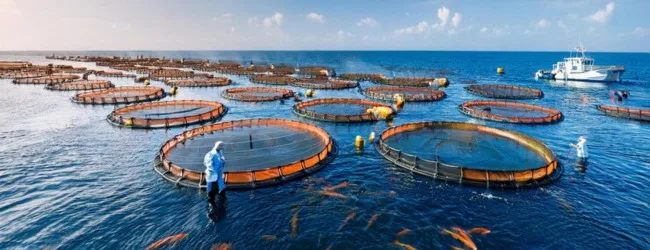Oyster farming in India presents a promising avenue for coastal communities to enhance their income and contribute to the aquaculture sector. With a long coastline and suitable environmental conditions in many regions, India holds significant potential for the sustainable cultivation of these valuable bivalve molluscs. This article delves into the techniques, investment aspects, profitability, and other crucial details of oyster farming in India.
Why Oyster Farming in India?
- Growing Demand: There’s an increasing domestic and international demand for oysters, driven by their nutritional value and culinary appeal.
- Economic Opportunities: Oyster farming can provide a significant source of income and employment, especially in coastal areas.
- Relatively Low Investment: Compared to some other aquaculture practices, oyster farming can be initiated with moderate investment.
- Environmental Benefits: Oyster farming can have positive environmental impacts by filtering water and creating habitats for other marine organisms.
- Government Support: The Indian government and various agencies are promoting aquaculture, including oyster farming, through various schemes and initiatives.
Suitable Regions for Oyster Farming in India

India’s extensive coastline offers diverse environments suitable for oyster cultivation. Some of the prominent regions include:
- Andhra Pradesh: Offers brackish water bodies ideal for oyster farming.
- Tamil Nadu: Has a significant coastline with potential for oyster culture.
- Kerala: Backwaters and coastal areas provide suitable conditions.
- Karnataka: Select coastal regions are conducive to oyster farming.
- Goa: Estuaries and backwaters offer opportunities.
- Maharashtra: Coastal areas have potential for oyster cultivation.
- West Bengal: Sundarbans region presents brackish water environments.
- Odisha: Chilika Lake and other coastal areas are suitable.
It’s crucial to conduct site-specific assessments to determine the optimal locations based on factors like salinity, water flow, and pollution levels.
💡 Pro Tip: If you want to start a farming business but have too many doubts, connect with a farming business expert from Boss Wallah for guidance – Check Out
Popular Oyster Species for Farming in India
The two main oyster species commonly farmed in India are:
- Indian Backwater Oyster (Crassostrea madrasensis): This species is well-adapted to the brackish water environments found along the Indian coast.
- Pacific Oyster (Crassostrea gigas): Introduced in some areas due to its fast growth rate and high market value. However, careful consideration is needed regarding its potential ecological impact.
Oyster Cultivation Techniques
Several methods are employed for oyster farming in India, each with its advantages and disadvantages:
- On-Bottom Culture: This traditional method involves directly placing oyster seeds (spat) on the seabed in suitable intertidal or subtidal areas.
- Simple and low-cost.
- Suitable for large areas.
- Susceptible to predation and siltation.
- Off-Bottom Culture: These methods involve raising oysters above the seabed, offering better protection and water circulation.
- Rack and Tray Method: Oysters are placed in mesh trays supported by racks made of wood or metal.
- Improved survival and growth rates.
- Easier harvesting.
- Higher initial investment.
- Longline Method: Strings of oyster shells or cultches with attached spat are suspended from long horizontal ropes supported by buoys.
- Suitable for deeper waters.
- Good water circulation.
- Requires more technical expertise.
- Floating Bag Method: Oysters are grown in mesh bags that float on the water surface, supported by floats.
- Excellent water exchange and food availability.
- Requires regular cleaning to prevent biofouling.
- Can be affected by strong winds and waves.
- Pole Method: Strings of oyster shells with spat are hung from poles driven into the seabed in intertidal areas.
- Low cost and simple to manage.
- Limited to intertidal zones.
- Rack and Tray Method: Oysters are placed in mesh trays supported by racks made of wood or metal.
Choosing the appropriate cultivation technique depends on factors like the site conditions, available resources, and scale of operation.
Investment in Oyster Farming

The initial investment for oyster farming in India can vary significantly based on the chosen cultivation method, scale of operation, and location. Key cost components include:
- Seed (Spat) Purchase: The cost of oyster spat depends on the species and source (hatchery-produced or wild-collected).
- Equipment and Materials: This includes racks, trays, longlines, buoys, floats, mesh bags, poles, and other necessary infrastructure.
- Lease or Access Fees: Depending on the location, there might be costs associated with leasing water bodies or obtaining permits.
- Labour Costs: Expenses for farm setup, maintenance, and harvesting.
- Transportation Costs: For transporting seeds, materials, and harvested oysters.
- Contingency Funds: It’s always advisable to have a buffer for unexpected expenses.
Example: A small-scale oyster farm using the rack and tray method in Andhra Pradesh might require an initial investment ranging from ₹1 lakh to ₹5 lakh, depending on the size and materials used. Larger commercial operations using longline or floating bag methods would entail significantly higher investments.
Profitability of Oyster Farming
The profitability of oyster farming in India is influenced by several factors, including:
- Production Yield: The number and size of oysters harvested per unit area. This depends on the cultivation technique, water quality, and management practices.
- Market Price: The selling price of oysters, which can vary based on size, quality, and market demand. Farm-gate prices in India can range from ₹50 to ₹200 per dozen, depending on the region and market.
- Operational Costs: Expenses incurred during the farming cycle, including labour, maintenance, and harvesting.
- Mortality Rates: The percentage of oysters that die during the cultivation period.
- Time to Market: The duration it takes for oysters to reach marketable size (typically 8-18 months).
Example: A well-managed oyster farm in Kerala using the rack and tray method could potentially yield 5,000 to 10,000 marketable oysters per year from a relatively small area. If sold at an average price of ₹100 per dozen, this could generate a gross revenue of ₹40,000 to ₹80,000. After deducting operational costs, a net profit of 20-40% could be achievable.
Highlight: Efficient farm management, selection of high-quality spat, and access to good markets are crucial for maximising profitability in oyster farming.
Key Considerations for Oyster Farmers in India
- Site Selection: Choosing a site with optimal salinity, water flow, and minimal pollution is paramount for successful oyster farming.
- Spat Procurement: Sourcing healthy and disease-free spat from reliable hatcheries or through controlled natural collection is essential.
- Water Quality Management: Regular monitoring of water quality parameters (temperature, salinity, dissolved oxygen, pH) is necessary to ensure optimal growth and survival.
- Biofouling Control: Preventing the accumulation of unwanted organisms (like barnacles and algae) on oyster shells and farming equipment is crucial for oyster health and growth.
- Disease Management: Implementing biosecurity measures and being vigilant for signs of oyster diseases is important to prevent significant losses.
- Harvesting and Post-Harvest Handling: Harvesting oysters at the right size and employing proper post-harvest handling techniques (cleaning, grading, storage) are vital for maintaining quality and market value.
- Marketing and Sales: Establishing effective marketing channels and building relationships with buyers (restaurants, hotels, seafood processors) is key to ensuring good returns.
- Regulations and Permits: Understanding and complying with the relevant regulations and obtaining necessary permits from fisheries departments and other authorities is mandatory.
ALSO READ | Commercial Farming in India: Types, Advantages, Challenges & More
Support and Training

Several institutions and organisations in India provide training and support for oyster farming, including:
- Central Marine Fisheries Research Institute (CMFRI)
- Central Institute of Brackishwater Aquaculture (CIBA)
- State Fisheries Departments
- Agricultural Universities
- Non-Governmental Organizations (NGOs)
Highlight: Participating in training programs and seeking guidance from experts can significantly enhance the success rate of oyster farming ventures.
ALSO READ | Pistachio Farming in India: How to Grow, Setup Cost, Profit & More
Need Expert Guidance?
Starting a business can be challenging, but you don’t have to do it alone! At Boss Wallah, our 2,000+ business experts are ready to provide valuable insights and guidance. Whether you need help with marketing, finance, sourcing, or any other area of any business, our business experts are here to help you succeed- Check Out
Confused about Which Business to Start?
Want to start your own business but unsure which one to choose? Explore Boss Wallah, where you’ll find 500+ courses by successful business owners, featuring practical, step-by-step guides on starting and growing various businesses.
Find your perfect business idea today – Check Out
Conclusion
Oyster farming in India holds significant promise for sustainable aquaculture development and economic empowerment of coastal communities. By understanding the appropriate cultivation techniques, managing investments wisely, and focusing on quality and market access, individuals and entrepreneurs can successfully venture into this rewarding sector. With increasing demand and growing support, the future of oyster farming in India looks bright.
Frequently Asked Questions (FAQs)
- What are the basic requirements for starting oyster farming in India?
Suitable brackish or seawater area, oyster spat, basic farming equipment, and necessary permits. - How long does it take for oysters to grow to marketable size?
Typically 8 to 18 months, depending on the species and environmental conditions. - What is the average cost of oyster spat in India?
The cost varies but can range from ₹2 to ₹10 per piece. - Is oyster farming profitable in India?
Yes, with proper management and market access, oyster farming can be a profitable venture. - What are the common challenges faced by oyster farmers in India?
Water pollution, diseases, biofouling, and market fluctuations. - Are there any government schemes to support oyster farming in India?
Yes, various schemes under the National Fisheries Development Board (NFDB) and state fisheries departments may provide assistance. - What type of water is best for oyster farming?
Brackish water with a salinity range of 15-30 ppt is generally ideal. - Do oysters require feeding in farms?
No, oysters are filter feeders and obtain their food (plankton) naturally from the water. - What is the best time to harvest oysters?
Typically, during the cooler months when they have good meat content and quality. - Where can I get training on oyster farming in India?
CMFRI, CIBA, state fisheries departments, and agricultural universities offer training programs.


